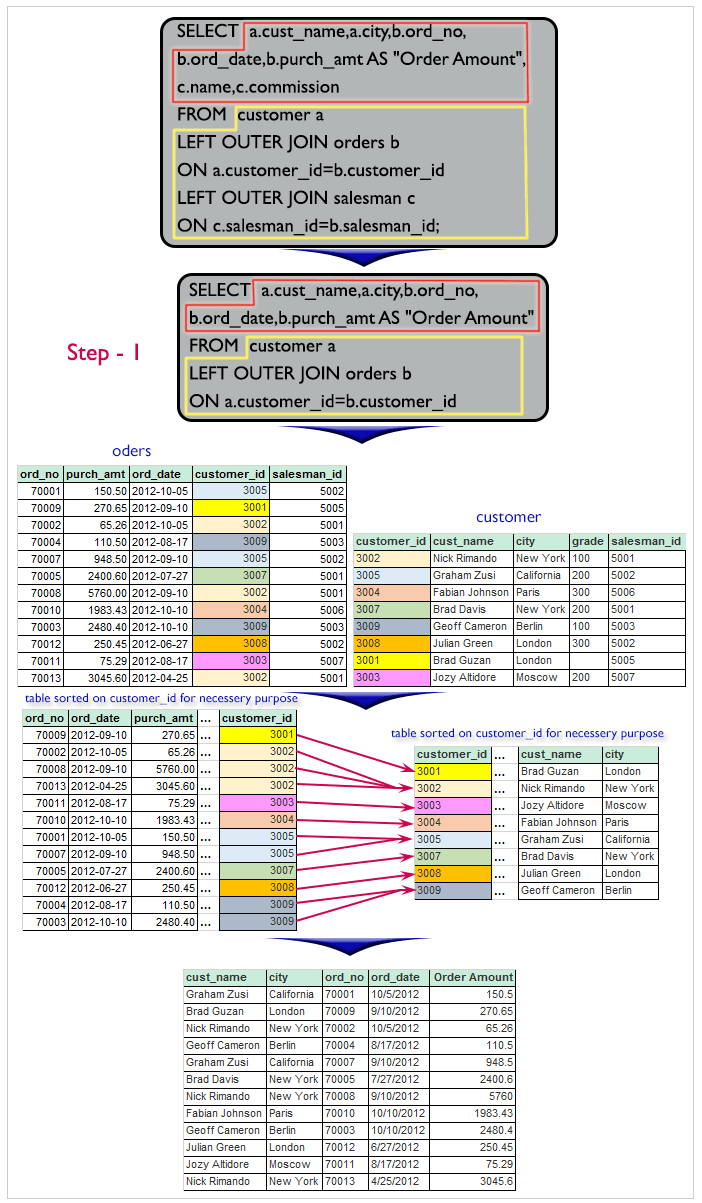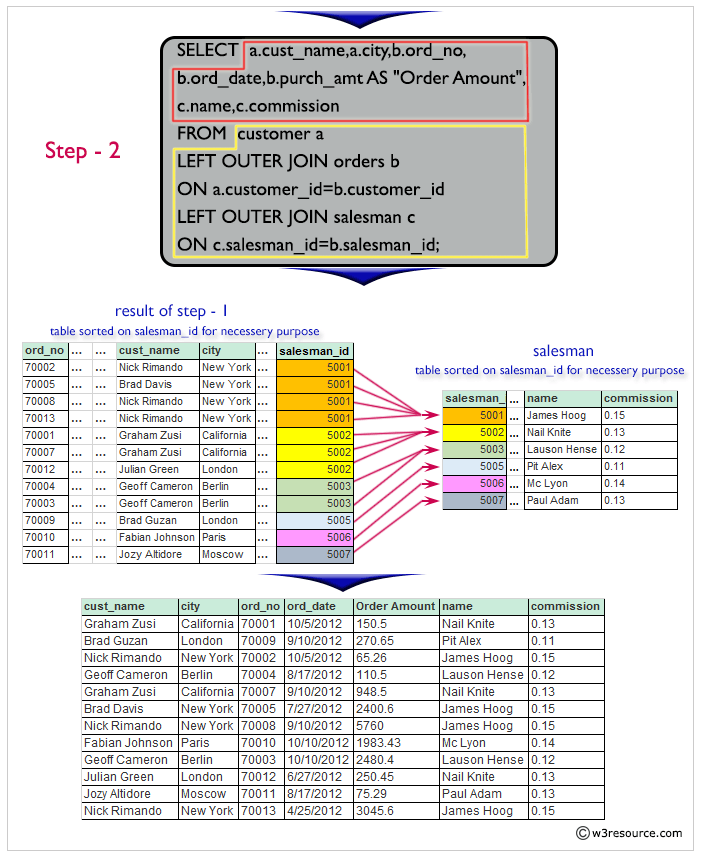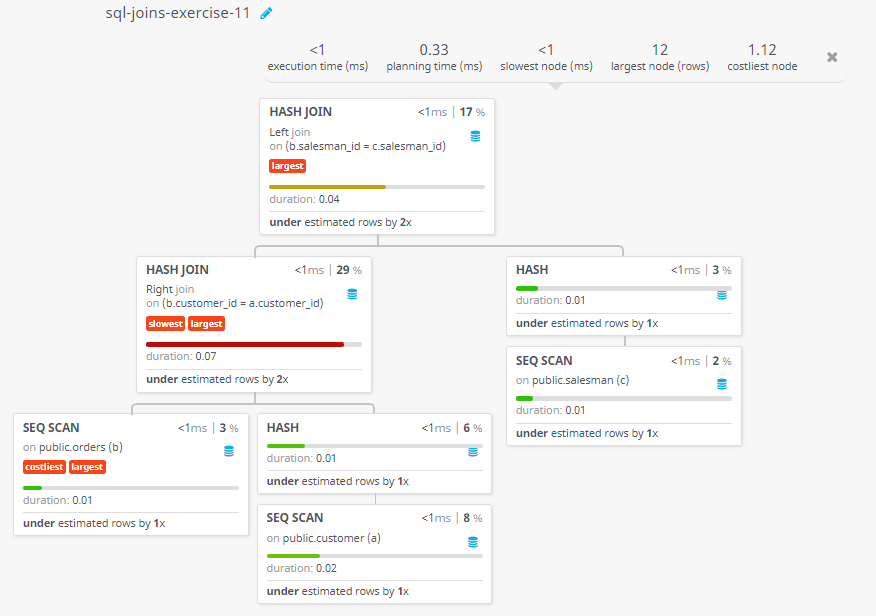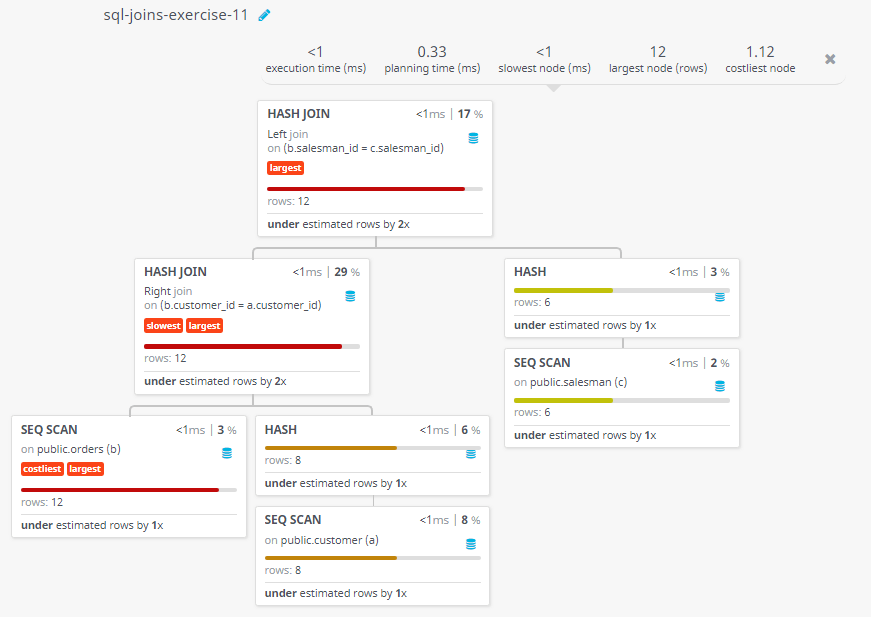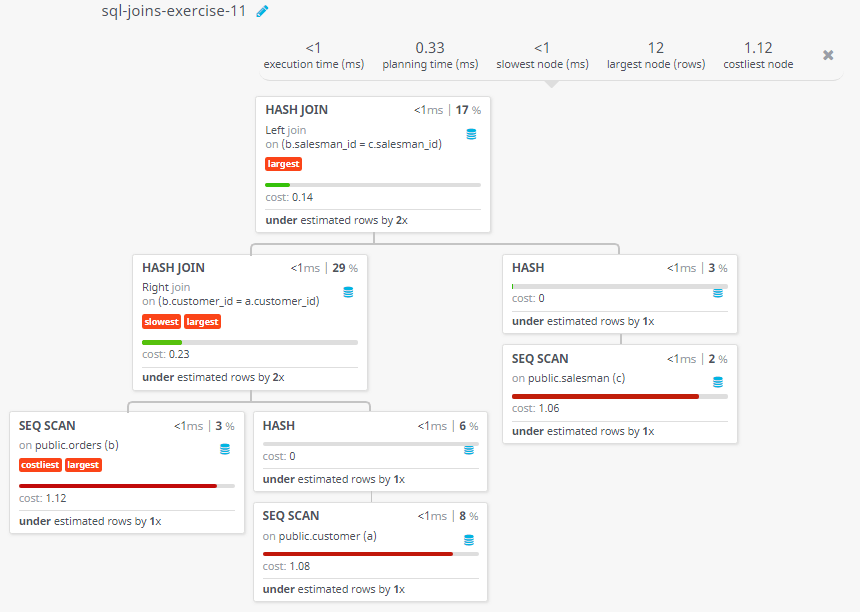SQL Exercise: Find customers who have placed no order or one or more
11. Order & Salesperson Report
SQL statement to generate a report with customer name, city, order number, order date, order amount, salesperson name, and commission to determine if any of the existing customers have not placed orders or if they have placed orders through their salesman or by themselves.
Sample table: customer
customer_id | cust_name | city | grade | salesman_id
-------------+----------------+------------+-------+-------------
3002 | Nick Rimando | New York | 100 | 5001
3007 | Brad Davis | New York | 200 | 5001
3005 | Graham Zusi | California | 200 | 5002
3008 | Julian Green | London | 300 | 5002
3004 | Fabian Johnson | Paris | 300 | 5006
3009 | Geoff Cameron | Berlin | 100 | 5003
3003 | Jozy Altidor | Moscow | 200 | 5007
3001 | Brad Guzan | London | | 5005
Sample table: orders
ord_no purch_amt ord_date customer_id salesman_id ---------- ---------- ---------- ----------- ----------- 70001 150.5 2012-10-05 3005 5002 70009 270.65 2012-09-10 3001 5005 70002 65.26 2012-10-05 3002 5001 70004 110.5 2012-08-17 3009 5003 70007 948.5 2012-09-10 3005 5002 70005 2400.6 2012-07-27 3007 5001 70008 5760 2012-09-10 3002 5001 70010 1983.43 2012-10-10 3004 5006 70003 2480.4 2012-10-10 3009 5003 70012 250.45 2012-06-27 3008 5002 70011 75.29 2012-08-17 3003 5007 70013 3045.6 2012-04-25 3002 5001
Sample table: salesman
salesman_id | name | city | commission
-------------+------------+----------+------------
5001 | James Hoog | New York | 0.15
5002 | Nail Knite | Paris | 0.13
5005 | Pit Alex | London | 0.11
5006 | Mc Lyon | Paris | 0.14
5007 | Paul Adam | Rome | 0.13
5003 | Lauson Hen | San Jose | 0.12
Sample Solution:
-- Selecting specific columns and renaming one column for clarity
SELECT a.cust_name, a.city, b.ord_no,
b.ord_date, b.purch_amt AS "Order Amount",
c.name, c.commission
-- Specifying the tables to retrieve data from ('customer' as 'a', 'orders' as 'b', and 'salesman' as 'c')
FROM customer a
-- Performing a left outer join based on the customer_id, including unmatched rows from 'customer'
LEFT OUTER JOIN orders b
ON a.customer_id = b.customer_id
-- Performing another left outer join with the result of the previous join and the 'salesman' table based on salesman_id
LEFT OUTER JOIN salesman c
ON c.salesman_id = b.salesman_id;
Output of the Query:
cust_name city ord_no ord_date Order Amount name commission Brad Guzan London 70009 2012-09-10 270.65 Pit Alex 0.11 Nick Rimando New York 70002 2012-10-05 65.26 James Hoog 0.15 Geoff Cameron Berlin 70004 2012-08-17 110.50 Lauson Hen 0.12 Brad Davis New York 70005 2012-07-27 2400.60 James Hoog 0.15 Nick Rimando New York 70008 2012-09-10 5760.00 James Hoog 0.15 Fabian Johnson Paris 70010 2012-10-10 1983.43 Mc Lyon 0.14 Geoff Cameron Berlin 70003 2012-10-10 2480.40 Lauson Hen 0.12 Jozy Altidor Moscow 70011 2012-08-17 75.29 Paul Adam 0.13 Nick Rimando New York 70013 2012-04-25 3045.60 James Hoog 0.15 Graham Zusi California 70001 2012-10-05 150.50 Nail Knite 0.13 Graham Zusi California 70007 2012-09-10 948.50 Nail Knite 0.13 Julian Green London 70012 2012-06-27 250.45 Nail Knite 0.13
Explanation:
The said SQL query is selecting the customer name, city, order number, order date, purchase amount, salesman name and commission from 3 tables customer aliased as a, orders aliased as b, and salesman aliased as c. It is joining these tables on the 'customer_id' and 'salesman_id' column respectively.
Additionally, it is using two LEFT OUTER JOINs, which will retrieve all records from the left table and the matching records from the right table. If no match is found on the right table, it will return NULL for the right table's fields.
This query will retrieve all customer details, order details and salesman details along with their commission even if some customer or salesman doesn't have any orders.
Visual Explanation:
Go to:
PREV : Customer Order Report by Date.
NEXT : Salespersons List (Including Unassigned).
Practice Online
Query Visualization:
Duration:
Rows:
Cost:
For more Practice: Solve these Related Problems:
- Write a SQL query to generate a report showing customer name, city, order number, order date, order amount, salesperson name, and commission by appropriately joining the tables.
- Write a SQL query to list detailed order information with associated salesperson details, filtering to show only orders placed through a salesperson.
- Write a SQL query to produce a comprehensive report of orders including customer and salesperson data, sorted by order date.
- Write a SQL query to display a detailed report with customer, order, and salesperson information, ensuring customers without orders are also shown with NULLs.
Have another way to solve this solution? Contribute your code (and comments) through Disqus.
What is the difficulty level of this exercise?
Test your Programming skills with w3resource's quiz.

